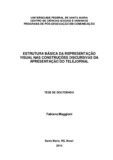| dc.creator | Maggioni, Fabiano | |
| dc.date.accessioned | 2015-10-21 | |
| dc.date.available | 2015-10-21 | |
| dc.date.issued | 2015-02-20 | |
| dc.identifier.citation | MAGGIONI, Fabiano. BASIC STRUCTURE OF VISUAL REPRESENTATION IN THE DICURSIVE CONTRUCTIONS OF TELEVISION NEWS PRESENTATION. 2015. 194 f. Tese (Doutorado em Comunicação) - Universidade Federal de Santa Maria, Santa Maria, 2015. | por |
| dc.identifier.uri | http://repositorio.ufsm.br/handle/1/3429 | |
| dc.description.abstract | The way news is presented on television news prompted me to find out the logic television follows to converge languages such as verbal and visual in order to report facts in its complex utterances. In this context, this work aims to show the strength of iconicity in the production of senses involved in the presentation of some open television news in Brazil. Therefore, this narrative is regarded as television news utterances, which consists of two dimensions of sense, plastic and semantic, working in conjunction with verbal language. The fragments chosen to analyze the corpus are taken from television news presentation performances, understood as everything that is given in the live studio. The method sought to approach the Spanish theory of image with the French semiology of social discourses. We considered the views of image authors such as Justo Villafañe, Norberto Mínguez, Rudolf Arnheim and Wassily Kandinsky. To understand the discursive semantic instance we approached the thoughts of Diana L. P. de Barros and Patrick Charaudeau. At the end, we made considerations that show the particularity of television news narrative run "live", a time similar to the time of the language designated by Émile Benveniste, and which is established at the time of the utterance. This time ends up influencing the formation of senses of the narrative of television news presentation. Based on how television news works its utterances live, it was possible to detect groups of effects of sense formed from the iconicity of images and molded according to the television news genre. They are effects of truth and reality, centrality, transience, and ubiquity. These senses are primarily made of an iconic scheme, created by image elements, and then they receive a thematic and a figurative structure as well as figurative addition. | eng |
| dc.description.sponsorship | Coordenação de Aperfeiçoamento de Pessoal de Nível Superior | |
| dc.format | application/pdf | por |
| dc.language | por | por |
| dc.publisher | Universidade Federal de Santa Maria | por |
| dc.rights | Acesso Aberto | por |
| dc.subject | Imagem | por |
| dc.subject | Telejornal | por |
| dc.subject | Icônico | por |
| dc.subject | Enunciação | por |
| dc.subject | Discurso | por |
| dc.subject | Image | eng |
| dc.subject | Television news | eng |
| dc.subject | Iconic | eng |
| dc.subject | Enunciation | eng |
| dc.subject | Discourse | eng |
| dc.title | Estrutura básica da representação visual nas construções discursivas da apresentação do telejornal | por |
| dc.title.alternative | Basic structure of visual representation in the dicursive contructions of television news presentation | eng |
| dc.type | Tese | por |
| dc.description.resumo | O modo como as notícias são apresentadas no telejornal me instigou a procurar saber que lógica a televisão segue para fazer confluir linguagens como a verbal e visual, com o objetivo de relatar fatos, no complexo enunciado televisivo. Dentro deste contexto, este trabalho procura mostrar a força da iconicidade na produção de sentidos envolvidos nas apresentações de alguns telejornais de TV aberta no Brasil. Para tanto, tal narrativa é considerada como enunciado televisivo noticioso composto por duas dimensões de significado, a plástica e a semântica, atuando em conjunção com a linguagem verbal. O recorte do corpus de análise é feito em torno das performances de apresentação do telejornal, compreendido a tudo que é dado no estúdio ao vivo. O método aplicado procurou aproximar a teoria da imagem espanhola com a semiologia dos discursos sociais francesa. Foram considerados pensamentos de autores da imagem como Justo Villafañe, Norberto Mínguez, Rudolf Arnheim e Wassily Kandinsky. Para compreender a instância discursiva semântica foi feita aproximação com os pensamentos de Diana L. P. de Barros e Patrick Charaudeau. Ao fim, foram possíveis considerações que mostram a particularidade da narrativa noticiosa televisiva executada no tempo "ao vivo", um tempo semelhante ao tempo linguístico designado por Émile Benveniste e que é instituído no momento da enunciação. Tal tempo acaba por influenciar a formação de sentidos da narrativa de apresentação do telejornal. Com base na forma como o telejornal trabalha seu enunciado ao vivo, foi possível detectar grupos de efeitos de sentido formados a partir da iconicidade da imagem e moldados ao gênero telejornalístico. São eles os efeitos de verdade e realidade, de centralidade, de transitoriedade e o efeito de ubiquidade. Tais sentidos são constituídos primeiramente por um esquema icônico, elaborado por elementos de imagem, e em seguida recebem estrutura temática e acréscimo figurativo. | por |
| dc.contributor.advisor1 | Peruzzolo, Adair Caetano | |
| dc.contributor.advisor1Lattes | http://buscatextual.cnpq.br/buscatextual/visualizacv.do?id=K4793259U6 | por |
| dc.contributor.referee1 | Soster, Demétrio de Azeredo | |
| dc.contributor.referee1Lattes | http://lattes.cnpq.br/3224345340267508 | por |
| dc.contributor.referee2 | Borelli, Viviane | |
| dc.contributor.referee2Lattes | http://buscatextual.cnpq.br/buscatextual/visualizacv.do?id=K4700458E2 | por |
| dc.contributor.referee3 | Bacaltchuk, Benami | |
| dc.contributor.referee3Lattes | http://buscatextual.cnpq.br/buscatextual/visualizacv.do?id=K4774554Z0 | por |
| dc.contributor.referee4 | Petermann, Juliana | |
| dc.contributor.referee4Lattes | http://buscatextual.cnpq.br/buscatextual/visualizacv.do?id=K4779258Z6 | por |
| dc.creator.Lattes | http://buscatextual.cnpq.br/buscatextual/visualizacv.do?id=K4539964Y3 | por |
| dc.publisher.country | BR | por |
| dc.publisher.department | Comunicação | por |
| dc.publisher.initials | UFSM | por |
| dc.publisher.program | Programa de Pós-Graduação em Comunicação | por |
| dc.subject.cnpq | CNPQ::CIENCIAS SOCIAIS APLICADAS::COMUNICACAO | por |


